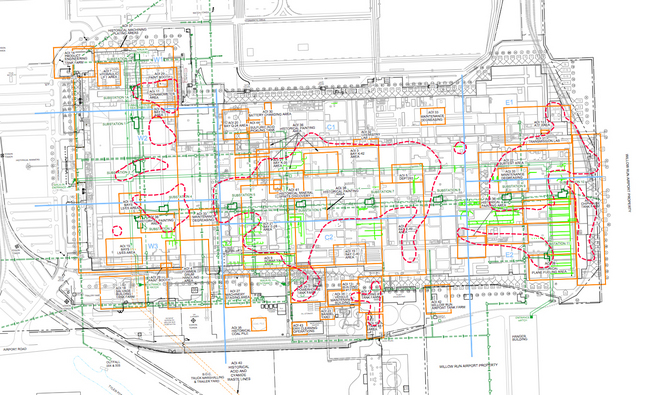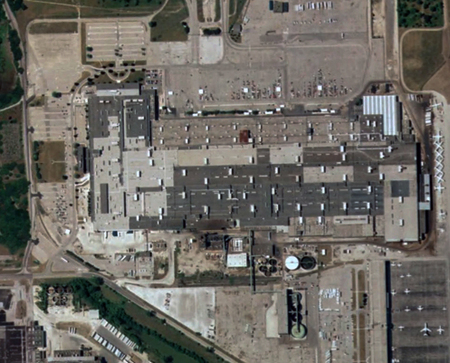Demolition of Willow Run Powertrain Plant could affect environmental remediation

The Willow Run Powertrain Plant in Ypsilanti Township. The areas marked by red dotted lines indicate where about 4.1 million gallons of oil and solvents have contaminated the groundwater below.
Courtesy of MDEQ
Of the 66 properties left vacant after General Motors Corp. filed for bankruptcy in 2009, the site of this plant remains one of the biggest environmental liabilities the company has left behind.
In the settlement agreement that formed the property’s owner — RACER Trust — about $35.8 million of the federal government’s money was allocated to environmental remediation efforts underneath the 83-acre footprint of the facility.
Talks of demolishing the cavernous building have begun to dominate the conversation of redevelopment efforts as RACER Trust entertains interest in the property from numerous parties.

An aerial photo of the GM Powertrain Plant in Ypsilanti Township in 2005.
The pollution
The allocation of $35.8 million for environmental cleanup was based on an evaluation by the Michigan Department of Environmental Quality and the U.S. Environmental Protection Agency on the extent of the pollution at the site.
That allocation makes the site GM’s biggest environmental liability in Michigan, and the second-largest in the country. It’s second only to the Massena Superfund site in New York -- to which the government allocated about $120.9 million for cleanup in the settlement agreement.
Grant Trigger, a professional engineer and environmental attorney, is the cleanup manager for the former GM properties in Michigan.

Grant Trigger
GM first became aware of the pollution problem underneath the Willow Run Powertrain Plant in the early 1980s.
“(The contamination) didn’t happen in a short period of time,” Trigger said, explaining that it’s hard to tell now how long the pollution was seeping into the ground. “The bulk of the manufacturing happened in GM’s tenure … in that 60-odd years, how much contamination was released over that period of time?”
Spills of oils and solvents — technically known as Light Non-Aqueous Phase Liquids — were found underground beneath areas of intensive metal processing and underneath sumps, pits, tanks and flumes in the plant.
Underneath the concrete slab on which the plant sits, there are about 40 acres that have been identified as spill sites where oil and solvents have seeped in to the groundwater aquifer that’s about eight to 15 feet underground.
A layer of oil on top of the groundwater aquifer varies from 0.3 feet to three feet thick, according to DEQ reports. Soil underneath the building also is contaminated.
The oil and solvents contain a number of pollutants:
- Volatile organic compounds including cis-1,2-dichloroethene, TCE, vinyl chloride, ethylbenzene, xylenes, methylene chloride
- Semi volatile organic compounds fluoranthene and phenanthrene
- Inorganic compounds of aluminum, arsenic, barium, copper, iron, manganese, mercury, nickel, selenium, vanadium and zinc
- PCBs
Limited investigative and remedial efforts were completed in the 1980s and 1990s, and two remedial investigations were completed in 2001 and 2003.
Since then, there have been no significant environmental cleanup projects, Trigger said.
An investigation contracted in 2010 of the infrastructure underneath the Willow Run Powertrain Plant found leaks from several underground structures, including transformers, tanks, sewer lines, hydraulic lifts and utility corridors like steam tunnels and large-diameter sewers, the DEQ reports stated.
There are about 46 areas of concern on the site.
Stormwater flows
A stormwater drain installed under the entire 83-acre footprint of the building also lies beneath the contaminated groundwater — meaning that the polluted water by nature flows into the collection system.
That stormwater collected underneath the building is treated at a wastewater treatment facility at the Powertrain Plant where the oil and solvents are removed.
HISTORY
Willow Run Powertrain Plant
- The Ford Motor Company built the 2.5 million-square-foot plant on a farm field in 1941 to manufacture B-24 bombers in WWII
- The Kaiser-Frazer Company leases the plant in 1945 and leases the plant in 1948, refurbishing it to make automobiles until it disbanded operations in 1953
- GM purchased the plant in 1953 to manufacture vehicle transmissions
- GM vacated the plant in 2010
The water then flows to the Ypsilanti Community Utilities Authority’s wastewater treatment plant, where it is once-again processed.
Water treated at the Powertrain Plant meets the standards required by the YCUA, according to the DEQ.
The YCUA discharges its treated water near the intersection of Geddes and Beck roads in Canton into the lower Rouge River, which eventually will dumps into the Detroit River and Lake Erie. The YCUA facility meets the requirements of the National Pollutant Discharge Elimination System.
The placement of the stormwater collection system underneath the Powertrain Plant is important in the environmental cleanup process, Trigger said, as it means the contaminated water it collects is treated before it leaves the property.
“In this instance, it’s an advantage for the site,” Trigger said. “While there’s contamination on the site, it’s treated at the plant.”
Kevin Lund, senior geologist with the DEQ working with RACER Trust, said the stormwater recovery system that collects some of the contaminated water and the on-site water treatment facility are key factors in containing the pollution at the site.
"We think there is no immediate threat to human health or to the environment under current conditions," Lund said in an email to AnnArbor.com.
Groundwater in the area generally flows from the northwest to the southeast and is being tracked through monitoring wells, Trigger said.
“We don’t believe there’s groundwater contamination migrating,” Trigger said. “There’s no evidence that it’s moving toward the stream.”
Stormwater runoff from the parking lots and other surfaces surrounding the GM Powertrain Plant flows into Tyler Pond, a man-made pond on the property connected to Willow Run's watershed.
Cleanup plans
The $35.8 million environmental cleanup budget is targeted at the contamination underneath the building.
The goal of RACER Trust’s efforts are to separate the contaminated groundwater from the water that runs off the roof of the plant and into the ground. They're also seeking to develop a longterm strategy to manage the cleanup of the groundwater.
“We’re trying to find a remedy that allows us to treat the contaminated water without mixing the stormwater into it,” Trigger said.

The Willow Run bomber plant in 1945.
Courtesy of the MDEQ
The remaining site evaluations will be conducted this summer, Trigger said.
Within the next six months, Trigger said he expects to have a plan developed to separate stormwater runoff from the building from intermixing with the contaminated groundwater.
Trigger said he expects there to be a long-range plan in place for remediating the contaminated groundwater in the next two to four years. The DEQ would have to approve the plan.
The plan could include the demolition of the plant’s wastewater treatment facility and the construction of a new facility that’s cheaper to operate, Trigger said.
RACER Trust representatives — including Trigger — also will be meeting with Castro at the YCUA next week to discuss wastewater treatment options.
With demolition, new issues arise
The environmental remediation budget for the Willow Run Powertrain Plant was developed under the assumption the building would not be demolished and that the concrete slab on which the building sits would remain in place, according to DEQ reports.
“The concrete pad serves as a cap for the contamination,” Trigger said. “Demolition of the building does not require removal of the concrete pad.”
Recent statements by RACER Trust redevelopment manager Bruce Rasher indicate demolition of the building is now on the table as an option for redevelopment.
"At this time it is uncertain how potential demolition would change exposure and remediation costs," Lund said. "Possible ramifications of building demolition include changes in cost to manage contaminated groundwater/LNAPL and, if the concrete floor would be removed, potential exposure to contaminated soil."
The stormwater management system collecting the contaminated groundwater — on which the environmental remediation relies — could be disrupted with the removal of the concrete slab.
“The slab needs to remain in place,” Trigger said. “If we remove the slab, the environmental remedy is uncertain.”
Demolishing the 72-year-old building would bring with it a number of additional issues — like asbestos removal — RACER Trust’s $35.8 million cleanup budget does not cover.
“The building itself and things above-ground would be a property management issue,” Trigger said, noting those property management costs would be assessed to a developer.
"RACER and DEQ have limited funding to manage the human health and environmental risks at this property," Lund said. "The DEQ no longer has a viable long-term funding source to address legacy contaminated sites like (the Willow Run Power Train) and other contaminated facilities. We were fortunate to receive money from the bankruptcy process for this property.
"If we run out of funding from the bankruptcy process to manage the risks, and without a viable source to address legacy contamination sites, the public and environment may be exposed."
Amy Biolchini covers Washtenaw County, health and environmental issues for AnnArbor.com. Reach her at (734) 623-2552, amybiolchini@annarbor.com or on Twitter.


Comments
KateT
Tue, Apr 30, 2013 : 1:29 p.m.
Thank you so much for reporting on this! This is sick. You were saying this is GM's second largest environmental liability in the country. I hope this gets national press and attention. I hope great minds put a lot of thought and collaboration on this for the best possible outcome.
jns131
Wed, May 1, 2013 : 1:14 a.m.
It already has, has died and is being rehashed. We as taxpayers are paying for this fallout. This is why I will not pay for Chryslers errors. Not out my pocket, never. Ypsilanti Township will sue Chrysler if nothing else. We should not have to pay for anything else. As taxpayers you should be appalled.
TommyJ
Mon, Apr 29, 2013 : 11:50 p.m.
This plant sits next to an airport and a dump and an asphalt plant. How do these other businesses/activities fit into the overall 'health' of the area? That whole area has to be one giant contaminated area.
15crown00
Mon, Apr 29, 2013 : 8:09 p.m.
Ok people what do u suggest gets done?Somehow i don't think GM will volunteer to clean it up.
jns131
Mon, Apr 29, 2013 : 6 p.m.
This article does not surprise me in the least. After what? 70 years of building planes and transmissions and what is used to go into it can leak into the ground water. What a mess to clean up. Is Chrysler going to pay for this? Or does the township have to them too? Can't wait to hear the outcome on this one.
jns131
Tue, Apr 30, 2013 : 5:55 p.m.
That is the point. If that is not enough then where is the extra money going to come from? Guess where? Our pockets. Guess it is time to make Chrysler pony up to the table to pay for what more is needed. Stay out of my pockets Chrysler.
Amy Biolchini
Mon, Apr 29, 2013 : 6:59 p.m.
RACER Trust, the entity formed in the wake of GM's bankruptcy filings in 2009, is responsible for the environmental cleanup. The federal government allocated about $35.8 million to the cleanup of the Willow Run Powertrain Plant in a settlement agreement. It's a fixed budget. Should additional funds be needed to finish the environmental remediation, it's not immediately known where that money would come from. Read the settlement agreement here: http://www.racertrust.org/About_RACER/Settlement_Agreement
YpsiGirl4Ever
Mon, Apr 29, 2013 : 5:23 p.m.
This is a HUGE problem and why was the Ypsilanti Township Communities of West Willow and Sugarbrook not told of this environmental mess, since both sit next to the plant. Is this the reason our home values have not increased while other communities in the Township have? Where are our elected officials on this. Not happy about this story at all but Thanks A2.com for reporting it!
jns131
Mon, Apr 29, 2013 : 6:01 p.m.
Contact Brenda Stumbo. She should be able to help you with this mess and ideas on what to do about the clean up.
EyeHeartA2
Mon, Apr 29, 2013 : 5:21 p.m.
Hope they figure something out. Way too historic to tear down.
RUKiddingMe
Mon, Apr 29, 2013 : 4:14 p.m.
Is this the property SPARK is somehow involved in helping sell or whatever? My searches of A2.com are not finding me the article about SPARK claiming some involvement in selling a property that was ana abandoned plant of some sort; is this the one?
Amy Biolchini
Mon, Apr 29, 2013 : 4:10 p.m.
In researching this story, what I found particularly interesting was the extent of the contamination at the site and how important the concrete slab of the building is to keeping the contamination intact. We've previously reported that the Powertrain Plant is about 5 million square feet large. The building's physical footprint is 3.7 million square feet. For the purposes of this story, I used 83 acres to describe the footprint so as not to confuse the two million-square-foot figures. Documents pertaining to the environmental cleanup of the Powertrain Plant that I used to report this story can be found on RACER Trust's website here: http://www.racertrust.org/Properties/Detail?Id=11991
Amy Biolchini
Mon, Apr 29, 2013 : 6:51 p.m.
I emailed the board members of the New West Willow Neighborhood Association on this story and did not receive a response.
YpsiGirl4Ever
Mon, Apr 29, 2013 : 5:24 p.m.
Amy, You might want to gather comments in the future from residents and homeowners in the West Willow and Sugarbrook communities in Ypsilanti Township as for whatever happens to this environmental mess, directly affects both of these areas. Thanks!
Floyd R. Turbo
Mon, Apr 29, 2013 : 3:05 p.m.
You guys should read "The Corporation by Joel Bakan-it's at the AADL as a starting point. Externalities is a term everyone should know! Ever wonder, what IS abandoned property?? Can I have it? Should schoolchildren tidy up around abandoned housing or is that actually obscene, when their government officials would come on the same property donning moon-suit environmental gear?! In this GM case, the money appears to pay $8.73 . $35.8 million dollars/ 4.1 million gallons.... Sounds low to me! ( I kid, that's no t how it works, and I like the guy's name Grant Trigger ) the whole thing's a farce!!!!
ahi
Mon, Apr 29, 2013 : 2:45 p.m.
Can't sell it. Can't use it. Can't demolish it. Wonderful.
Nicholas Urfe
Mon, Apr 29, 2013 : 1:19 p.m.
Their remediation plan has more holes than the floor and those toxic oil pits. Sounds like they're at least a couple hundred million dollars short.
Mark H
Mon, Apr 29, 2013 : 1:12 p.m.
This case illustrates the great weakness in most environmental law, which is largely a forum for various polluters to avoid legal and financial liability for the environmental and health damages their actions create. GM will not be held liable for the full costs of the Willow Run plant's environmental impact -- that possibility has already been avoided by the courts and the law. Instead, people's health, the environment, and the taxpayers will bare the costs. The capitalist economy relies on externalizing the costs of environmental destruction on to the earth and its non-profitmaking components. Thus Willow Run and the global environmental crisis are one and the same.
beardown
Mon, Apr 29, 2013 : 2:53 p.m.
Spot on. The US government, which was still has a large deal of our money tied up into GM, had nothing to gain by holding them accountable in any way for their environmental transgressions. The good of the economy once again trumped the health and well being of the citizens. Add in the fact that WR is far from affluent made it even easier for GM to walk away with this paying a mere fraction of the costs.
mr54
Mon, Apr 29, 2013 : 12:08 p.m.
The new GM is not responsible for a darn thing.
A2comments
Mon, Apr 29, 2013 : 10:16 a.m.
It is absolutely outrageous that GM wasn't required to clean this up in the 80's or 90's, and that taxpayers are n the hook for this. The new GM should have to pay for some of it.
Michigan Reader
Mon, Apr 29, 2013 : 9:37 p.m.
The new GM won't...they didn't operate in that facility.